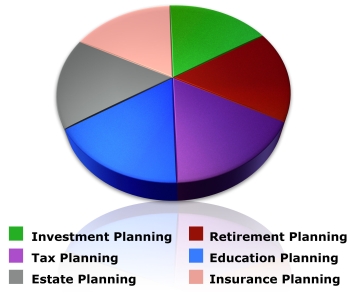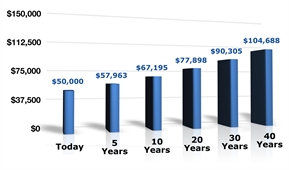 Keeping your cool can be hard to do when the market goes on one of its periodic roller-coaster rides. It’s useful to have strategies in place that prepare you both financially and psychologically to handle market volatility. Here are 11 ways to help keep yourself from making hasty decisions that could have a long-term impact on your ability to achieve your financial goals.
Keeping your cool can be hard to do when the market goes on one of its periodic roller-coaster rides. It’s useful to have strategies in place that prepare you both financially and psychologically to handle market volatility. Here are 11 ways to help keep yourself from making hasty decisions that could have a long-term impact on your ability to achieve your financial goals.
1. Have a game plan
Having predetermined guidelines that recognize the potential for turbulent times can help prevent emotion from dictating your decisions. For example, you might take a core-and-satellite approach, combining the use of buy-and-hold principles for the bulk of your portfolio with tactical investing based on a shorter-term market outlook. You also can use diversification to try to offset the risks of certain holdings with those of others. Diversification may not ensure a profit or guarantee against a loss, but it can help you understand and balance your risk in advance. And if you’re an active investor, a trading discipline can help you stick to a long-term strategy. For example, you might determine in advance that you will take profits when a security or index rises by a certain percentage, and buy when it has fallen by a set percentage.
2. Know what you own and why you own it
When the market goes off the tracks, knowing why you originally made a specific investment can help you evaluate whether your reasons still hold, regardless of what the overall market is doing. Understanding how a specific holding fits in your portfolio also can help you consider whether a lower price might actually represent a buying opportunity.
And if you don’t understand why a security is in your portfolio, find out. That knowledge can be particularly important when the market goes south, especially if you’re considering replacing your current holding with another investment.
3. Remember that everything is relative
Most of the variance in the returns of different portfolios can generally be attributed to their asset allocations. If you’ve got a well-diversified portfolio that includes multiple asset classes, it could be useful to compare its overall performance to relevant benchmarks. If you find that your investments are performing in line with those benchmarks, that realization might help you feel better about your overall strategy.
Even a diversified portfolio is no guarantee that you won’t suffer losses, of course. But diversification means that just because the S&P 500 might have dropped 10% or 20% doesn’t necessarily mean your overall portfolio is down by the same amount.
4. Tell yourself that this too shall pass
The financial markets are historically cyclical. Even if you wish you had sold at what turned out to be a market peak, or regret having sat out a buying opportunity, you may well get another chance at some point. Even if you’re considering changes, a volatile market can be an inopportune time to turn your portfolio inside out. A well-thought-out asset allocation is still the basis of good investment planning.
5. Be willing to learn from your mistakes
Anyone can look good during bull markets; smart investors are produced by the inevitable rough patches. Even the best investors aren’t right all the time. If an earlier choice now seems rash, sometimes the best strategy is to take a tax loss, learn from the experience, and apply the lesson to future decisions. Expert help can prepare you and your portfolio to both weather and take advantage of the market’s ups and downs.
6. Consider playing defense
During volatile periods in the stock market, many investors reexamine their allocation to such defensive sectors as consumer staples or utilities (though like all stocks, those sectors involve their own risks, and are not necessarily immune from overall market movements). Dividends also can help cushion the impact of price swings. According to Standard & Poor’s, dividend income has represented roughly one-third of the monthly total return on the S&P 500 since 1926, ranging from a high of 53% during the 1940s to a low of 14% in the 1990s, when investors focused on growth.
7. Stay on course by continuing to save
 Even if the value of your holdings fluctuates, regularly adding to an account designed for a long-term goal may cushion the emotional impact of market swings. If losses are offset even in part by new savings, your bottom-line number might not be quite so discouraging.
Even if the value of your holdings fluctuates, regularly adding to an account designed for a long-term goal may cushion the emotional impact of market swings. If losses are offset even in part by new savings, your bottom-line number might not be quite so discouraging.
If you’re using dollar-cost averaging–investing a specific amount regularly regardless of fluctuating price levels–you may be getting a bargain by buying when prices are down. However, dollar cost averaging can’t guarantee a profit or protect against a loss. Also consider your ability to continue purchases through market slumps; systematic investing doesn’t work if you stop when prices are down. Finally, remember that the return and principal value of your investments will fluctuate with changes in market conditions, and shares may be worth more or less than their original cost when you sell them.
8. Use cash to help manage your mind-set
Cash can be the financial equivalent of taking deep breaths to relax. It can enhance your ability to make thoughtful decisions instead of impulsive ones. If you’ve established an appropriate asset allocation, you should have resources on hand to prevent having to sell stocks to meet ordinary expenses or, if you’ve used leverage, a margin call. Having a cash cushion coupled with a disciplined investing strategy can change your perspective on market volatility. Knowing that you’re positioned to take advantage of a downturn by picking up bargains may increase your ability to be patient.
9. Remember your road map
Solid asset allocation is the basis of sound investing. One of the reasons a diversified portfolio is so important is that strong performance of some investments may help offset poor performance by others. Even with an appropriate asset allocation, some parts of a portfolio may struggle at any given time. Timing the market can be challenging under the best of circumstances; wildly volatile markets can magnify the impact of making a wrong decision just as the market is about to move in an unexpected direction, either up or down. Make sure your asset allocation is appropriate before making drastic changes.
10. Look in the rear-view mirror
If you’re investing long term, sometimes it helps to take a look back and see how far you’ve come. If your portfolio is down this year, it can be easy to forget any progress you may already have made over the years. Though past performance is no guarantee of future returns, of course, the stock market’s long-term direction has historically been up. With stocks, it’s important to remember that having an investing strategy is only half the battle; the other half is being able to stick to it. Even if you’re able to avoid losses by being out of the market, will you know when to get back in? If patience has helped you build a nest egg, it just might be useful now, too.
11. Take it easy
If you feel you need to make changes in your portfolio, there are ways to do so short of a total makeover. You could test the waters by redirecting a small percentage of one asset class to another. You could put any new money into investments you feel are well-positioned for the future, but leave the rest as is. You could set a stop-loss order to prevent an investment from falling below a certain level, or have an informal threshold below which you will not allow an investment to fall before selling. Even if you need or want to adjust your portfolio during a period of turmoil, those changes can–and probably should–happen in gradual steps. Taking gradual steps is one way to spread your risk over time, as well as over a variety of asset classes.
Words to ponder
“Investors should remember that excitement and expenses are their enemies. And if they insist on trying to time their participation in equities, they should try to be fearful when others are greedy and greedy when others are fearful.”
–Warren Buffett
“Most of the time common stocks are subject to irrational and excessive price fluctuations in both directions as the consequence of the ingrained tendency of most people to speculate or gamble … to give way to hope, fear and greed.”
–Benjamin Graham
“In this business if you’re good, you’re right six times out of ten. You’re never going to be right nine times out of ten.”
–Peter Lynch
IMPORTANT DISCLOSURES
Altum Wealth Advisors does not provide investment, tax, or legal advice via this website. The information presented here is not specific to any individual’s personal circumstances. To the extent that this material concerns tax matters, it is not intended or written to be used, and cannot be used, by a taxpayer for the purpose of avoiding penalties that may be imposed by law. Each taxpayer should seek independent advice from a tax professional based on his or her individual circumstances. These materials are provided for general information and educational purposes based upon publicly available information from sources believed to be reliable—we cannot assure the accuracy or completeness of these materials. The information in these materials may change at any time and without notice.
CIRCULAR 230 NOTICE: To ensure compliance with requirements imposed by the IRS, this notice is to inform you that any tax advice included in this communication, including any attachments, is not intended or written to be used, and cannot be used, for the purpose of avoiding any federal tax penalty or promoting, marketing, or recommending to another party any transaction or matter.
Prepared by Broadridge Investor Communication Solutions, Inc. Copyright 2015.
Prepared for Altum Wealth Advisors, Steven Cliadakis, MBA, CWS®, Managing Director, Wealth Strategist.







 Timing is everything
Timing is everything






